Right around Dragon Mountain the highway splits and QL19 heads west to Oasis and Duc Co and QL14 heads south. Just south of Plei Both Drane QL14 splits again, if you take the left fork (southeast) you will be on LTL7B that will take you to LZ Weigt Davis and beyond that, Cheo Reo. We continue south on QL14 and approximately 1KM south of Highway TL6D (that heads west to Plei Me) we arrived at the Phu Nhon District Headquarters and LZ Miller, as it is now known. I have no knowledge of what its name was before we arrived and it probably doesn't matter.
As we pulled into the main gate (heading east) the District Headquarters was straight ahead of the convoy. The U.S. and South Vietnam flags were flying in the breeze. I remember thinking this was going to be a pretty secure and safe place to be, and with 4 months left in country, I was on the down hill side of my tour. The convoy turned right (south) inside the compound and drove past the 20th Engineer Bn. part of the compound. We (the platoon and support crew) were there to provide fire support for the engineers working in the area. We continued past the water tower into our area (the entire southwest corner) of the compound. Coordinates AQ86799
We pulled the guns into their pits and dropped off the ammo, fuses, and powder. The Engineers had done a fairly decent job of getting us started with overhead cover for the main ammo storage, FDC, gun pit ready racks, and hootches, for that we were thankful. Don't get me wrong there was still "a shit load" of work to be done, but most of the heavy stuff they did with their equipment. When you think about it, the Engineers were almost contemptuous toward us. Maybe, because they had to share chow with us, or because, sometimes we beat them to the showers. But let's face the facts we took our fair share of cold showers and we kept a lot of their young Asses alive to work another day. We kept them alive, to go home and face yet another enemy. But that's another story.
We had two dusters on our perimeter. I don't know if they were there when we arrived, but they were there before nightfall. We always slept a little better when they were watching our flanks. It had to be hard sitting in that "can" when we fired those pigs off over their heads.
One thing I do remember is, the perimeter wire was so overgrown with weeds and grass, you couldn't see what you did or didn't have out there. One of the first things we did was set it on fire to get rid of the growth. We found there were dud 82mm mortar rounds from who knows where (from ARVN mortar crews or from Charlie?) imbedded into the soil out there. Also visible to us were "Betty's" three fingers, sticking out of the ground, warning us not to venture too far out into this area without the proper equipment.
The days passed and turned into weeks. The men of Charley Battery continued to build defenses, around and over the holes that were pushed into and around the battery area. They were spent quite "normally" for an artillery battery. Daily checks of the perimeter wire and claymore mines. Building guard posts. Firing registration and fire support missions in the day and night. Basically, "making the house a home".
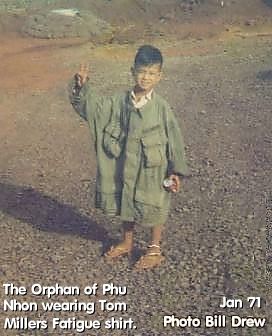 I don't remember when the orphan kid first showed up. I don't know from where he came. Maybe from the shacks around the compound, we always thought they were empty I don't know he was just there one day. He took to PFC Tom Miller like a baby chick and like a mother hen; PFC. Miller took to him. Although Miller and I were in the same gun crew, I didn't know much about his background or how he was raised. I didn't know if he was drafted or if he enlisted. I didn't know if he was married, or whether he had children at home. I took a couple of pictures of Tom and the kid crashed together. I know they really touched my heart (and I believe, the hearts of the men in Gun 4). Tom used to share his meals and bunk with the kid. The only time they were apart, was during fire missions and their daily "toilets." I don't remember when the orphan kid first showed up. I don't know from where he came. Maybe from the shacks around the compound, we always thought they were empty I don't know he was just there one day. He took to PFC Tom Miller like a baby chick and like a mother hen; PFC. Miller took to him. Although Miller and I were in the same gun crew, I didn't know much about his background or how he was raised. I didn't know if he was drafted or if he enlisted. I didn't know if he was married, or whether he had children at home. I took a couple of pictures of Tom and the kid crashed together. I know they really touched my heart (and I believe, the hearts of the men in Gun 4). Tom used to share his meals and bunk with the kid. The only time they were apart, was during fire missions and their daily "toilets."
Nearing the end of January our observation tower was completed. I took a series of six photos of the compound (from the top) spanning from one Duster on the east, to the other Duster on the west. Together, they give a really good view of the job everyone had accomplished at Phu Nhon.
Authors note: Looking at those pictures while writing this piece, it is easy to see why on 16 March 1971, the VC/NVA decided to overrun the District Headquarters and Territorial Artillery Platoon areas of the compound to the north of the C (Plt) 1/92nd Firebase. The place was a shambles with plenty of places to hide and lots of civilians with which to take advantage.
Anyway, the place was pretty comfortable. The perimeter wires were clean, or as clean as you could get it with "Betty" out there. The claymores were in their own little cubbyholes. The hooches were almost complete and covered with multiple layers of sandbags. The Duster crews had overhead protection for sleeping. The perimeter foxholes were finished and covered. The alternate (night) aiming circle was set up on top of FDC. The "Fall Back" foxholes on top of FDC and Gun 4's hooch were standing at the ready. We built another shower with two large holding tanks to take care of the added personnel. Hey, we even had perimeter lights. Like I said The place was pretty comfortable. Little did we know how uncomfortable our new home was about to become!
On the morning of 1 February 1971 at 0100hrs (oh dark thirty), we were asleep in our hooch when we were awakened for a fire mission. The VC/NVA were attacking the village of Plei Poe to our south approx. 7-10KM (1KM west of LZ Lonely.) No big deal, just like a thousand other times before it, right? Wrong! This time when we came out of the hooch into the night it was raining! Raining live, honest to goodness 82mm mortar rounds from a couple of VC/NVA tubes close enough for us to hear them leave. The sound I will never forget "Thoomp" "Thoomp" (kind of like the sound a firecracker makes when you put it down a long pipe). We counted the seconds before impact, so in-between them leaving the mortar and impacting the firebase, we could continue with the fire mission. They were still overshooting the gun pit, but you could tell they were walking them back toward us, as the elapsed time increased with each volley. The men of Gun 4 were doing instinctively what each one of them was trained to do. At the same time we were all counting the seconds off in our heads 8, 9, 10 DOWN! Each of us was taking cover wherever and however we could.
I was kneeling down (on my left knee) between the trails of the gun, thinking I had a pretty good spot with all that steel around me. Unfortunately, when the mortar rounds landed in the gun pit, they landed about one and a half feet from the gun, one on the left front of the gunners' tire and one on the AG's side between the trail and the ammo rack.
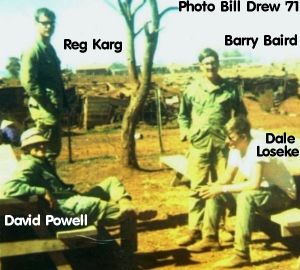 What I do remember very clearly was the flash of light, the searing heat, the sounds of the explosions, and the blackness that followed the detonation of those two mortar rounds. When I shook myself back to consciousness, I was laying spread-eagle between the azimuth sign and the ready rack for the "Firecracker" and "Willie Peter" rounds, on the parapet wall close to the entrance to the gun pit. Along with my flak jacket and steel pot, I was wearing a gray sweatshirt and sweatpants. When I looked down at my body to survey the damage, I saw a pretty horrible sight my left arm, abdomen (I forgot to zip my flak jacket), and left leg were soaked with blood. The material of my sweat clothes was torn to shreds. It scared the hell out of me! The confusion around me in the gun pit and the Firebase was just as scary. I didn't know how badly I was hurt and didn't know if I could walk. The first person I saw walking around, looking like they needed a purpose to exist, was the first person I yelled to for help. What I do remember very clearly was the flash of light, the searing heat, the sounds of the explosions, and the blackness that followed the detonation of those two mortar rounds. When I shook myself back to consciousness, I was laying spread-eagle between the azimuth sign and the ready rack for the "Firecracker" and "Willie Peter" rounds, on the parapet wall close to the entrance to the gun pit. Along with my flak jacket and steel pot, I was wearing a gray sweatshirt and sweatpants. When I looked down at my body to survey the damage, I saw a pretty horrible sight my left arm, abdomen (I forgot to zip my flak jacket), and left leg were soaked with blood. The material of my sweat clothes was torn to shreds. It scared the hell out of me! The confusion around me in the gun pit and the Firebase was just as scary. I didn't know how badly I was hurt and didn't know if I could walk. The first person I saw walking around, looking like they needed a purpose to exist, was the first person I yelled to for help.
Authors note: For reasons the reader will see I will not identify the person I called to for help other than to call him "FNG" (FNG refers to a 'F---ing New Guy' as distasteful as this term may be to some of us, it is one, we have all been and have endured.) FNG, if he were ever to read this, he would know who he is. From conversations with others from C Btry 1/92nd it is my understanding that he was sent back to Artillery Hill after this attack (the readers can judge for themselves, the reasons). Later during the "Siege of Phu Nhon" when LZ Miller was once again attacked by VC/NVA forces and re-supply was possible only by air, FNG was sent back. He was about 100 yards from the landing zone at LZ Miller when ground fire came through the floor of the Chinook and hit him in the foot. It is the authors' humble opinion; this was probably best for FNG and the men at LZ Miller.
I yelled, "FNG, FNG help me to the aid station!" FNG was in another world the terms dazed and confused or shell-shocked come to mind, when I think of the look in his eyes. FNG turned white as a sheet when he looked at me (which didn't do a lot for my confidence) and he turned around and walked away.
I didn't know if I could do it, but I wasn't about to lie there and bleed to death or become a target for whatever might come through our wire that morning. I would try walking first and if that didn't work, I would crawl to the aid station myself. When I stood up and found I could walk, I went into my own zone maybe it was the ringing in my ears or maybe it was just extreme concentration. Maybe it was the knack (which all gun bunnies have in order to sleep) to shut out the world. Whatever the reason, I don't remember anything other than being at the top of the stairs leading down to FDC, standing there and falling head first, and then just blackness again.
When I once again come back to consciousness, my clothes are cut off and open to expose my wounds. Red iodine antiseptic has been poured all over the exposed areas. I am FREEZING! Which can mean only one thing if you're in Vietnam shock was setting in. My mind once again goes blank. The next thing I remember is someone saying "Sgt. Powell the chopper is here, you're ambulatory, you can walk next to the jeep."
Authors note: The Daily Staff Journal or Duty Officers Log (DA1594's dated 1 Feb 71) lists the official count of 13 WIA and 1 KIA. They were from the 20th Engineers (4 WIA, 3 Med-evac'd), the 4/60th Dusters (2 WIA, 2 Med-evac'd) and C Btry 1/92nd (7WIA, 5 Med-evac'd and 1 KIA). The VC/NVA unit responsible for the attack is believed to be K-1, 95 Bravo.
Pope and Miller were on stretchers across the back of the jeep and the rest of us walked along beside it to where the Med-Evac chopper waited. The Medics loaded the stretchers, the rest of us (there were PFC Miller, PFC Pope, PFC Jimerson, SP4 McCurdy, SP4 Druin and me. I don't know who else, but I'm pretty sure there were more) climbed in and the chopper took off.
On the way to the MASH unit, one of the crewmen (I think it was the door gunner) aboard the chopper, told us to get rid of all the contraband we had no questions asked. Those holding turned it over. Someone may have passed a bowl around for medicinal reasons.
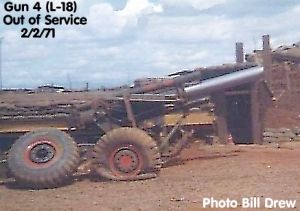 I had another shock-induced blackout, the next thing I knew I was waking up on a stretcher in the MASH unit. I looked around and saw Pope on his stretcher on the other side of Miller there were tears in his eyes when he said, "Sarge, we lost Tom". We watched, stunned as the doctors saved the life of a gook in the MASH unit. I thought (I can't speak for Pope) how in the hell could they expend so much energy to save that piece of meat and let Tom Miller die? I too cried (and when I go there in my mind, even to this day, I cry.) I had another shock-induced blackout, the next thing I knew I was waking up on a stretcher in the MASH unit. I looked around and saw Pope on his stretcher on the other side of Miller there were tears in his eyes when he said, "Sarge, we lost Tom". We watched, stunned as the doctors saved the life of a gook in the MASH unit. I thought (I can't speak for Pope) how in the hell could they expend so much energy to save that piece of meat and let Tom Miller die? I too cried (and when I go there in my mind, even to this day, I cry.)
I don't know how I got there, Hell; I didn't even know where I was. The next thing I remember, I'm being loaded into a transport plane for the flight to the Field Hospital. Once at the hospital, I'm placed on a gurney and wheeled into a huge receiving area where doctors are looking at us, barking orders for IV's, catheters, and tubes in noses and other unpleasant orifices. One of the doctors asks me if he can take my picture. I say "yes," he takes it and I'm wheeled off to the operating room. And as I go out again I remember thinking how 1 Feb. 1971 will be over when I wake up. Although, it will remain forever frozen in my memory.
*FNG means 'F---ing New Guy'
|
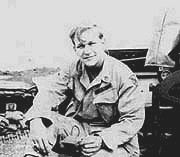
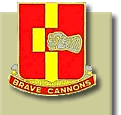

 I don't remember when the orphan kid first showed up. I don't know from where he came. Maybe from the shacks around the compound, we always thought they were empty I don't know he was just there one day. He took to PFC Tom Miller like a baby chick and like a mother hen; PFC. Miller took to him. Although Miller and I were in the same gun crew, I didn't know much about his background or how he was raised. I didn't know if he was drafted or if he enlisted. I didn't know if he was married, or whether he had children at home. I took a couple of pictures of Tom and the kid crashed together. I know they really touched my heart (and I believe, the hearts of the men in Gun 4). Tom used to share his meals and bunk with the kid. The only time they were apart, was during fire missions and their daily "toilets."
I don't remember when the orphan kid first showed up. I don't know from where he came. Maybe from the shacks around the compound, we always thought they were empty I don't know he was just there one day. He took to PFC Tom Miller like a baby chick and like a mother hen; PFC. Miller took to him. Although Miller and I were in the same gun crew, I didn't know much about his background or how he was raised. I didn't know if he was drafted or if he enlisted. I didn't know if he was married, or whether he had children at home. I took a couple of pictures of Tom and the kid crashed together. I know they really touched my heart (and I believe, the hearts of the men in Gun 4). Tom used to share his meals and bunk with the kid. The only time they were apart, was during fire missions and their daily "toilets."  What I do remember very clearly was the flash of light, the searing heat, the sounds of the explosions, and the blackness that followed the detonation of those two mortar rounds. When I shook myself back to consciousness, I was laying spread-eagle between the azimuth sign and the ready rack for the "Firecracker" and "Willie Peter" rounds, on the parapet wall close to the entrance to the gun pit. Along with my flak jacket and steel pot, I was wearing a gray sweatshirt and sweatpants. When I looked down at my body to survey the damage, I saw a pretty horrible sight my left arm, abdomen (I forgot to zip my flak jacket), and left leg were soaked with blood. The material of my sweat clothes was torn to shreds. It scared the hell out of me! The confusion around me in the gun pit and the Firebase was just as scary. I didn't know how badly I was hurt and didn't know if I could walk. The first person I saw walking around, looking like they needed a purpose to exist, was the first person I yelled to for help.
What I do remember very clearly was the flash of light, the searing heat, the sounds of the explosions, and the blackness that followed the detonation of those two mortar rounds. When I shook myself back to consciousness, I was laying spread-eagle between the azimuth sign and the ready rack for the "Firecracker" and "Willie Peter" rounds, on the parapet wall close to the entrance to the gun pit. Along with my flak jacket and steel pot, I was wearing a gray sweatshirt and sweatpants. When I looked down at my body to survey the damage, I saw a pretty horrible sight my left arm, abdomen (I forgot to zip my flak jacket), and left leg were soaked with blood. The material of my sweat clothes was torn to shreds. It scared the hell out of me! The confusion around me in the gun pit and the Firebase was just as scary. I didn't know how badly I was hurt and didn't know if I could walk. The first person I saw walking around, looking like they needed a purpose to exist, was the first person I yelled to for help.  I had another shock-induced blackout, the next thing I knew I was waking up on a stretcher in the MASH unit. I looked around and saw Pope on his stretcher on the other side of Miller there were tears in his eyes when he said, "Sarge, we lost Tom". We watched, stunned as the doctors saved the life of a gook in the MASH unit. I thought (I can't speak for Pope) how in the hell could they expend so much energy to save that piece of meat and let Tom Miller die? I too cried (and when I go there in my mind, even to this day, I cry.)
I had another shock-induced blackout, the next thing I knew I was waking up on a stretcher in the MASH unit. I looked around and saw Pope on his stretcher on the other side of Miller there were tears in his eyes when he said, "Sarge, we lost Tom". We watched, stunned as the doctors saved the life of a gook in the MASH unit. I thought (I can't speak for Pope) how in the hell could they expend so much energy to save that piece of meat and let Tom Miller die? I too cried (and when I go there in my mind, even to this day, I cry.)  4/60th Dusters expended 400 rounds at mortar flashes. A (Plt) 1/92nd Arty at LZ Weigt Davis fired 35 rounds of Illumination in support of Phu Nhon but could not fire counter mortar fire because of the 100 men RF night location 300 meters away from the mortar grid AQ878984. C (Plt) fired 71 Illumination and 47 HE in support of Plei Poe village, while taking incoming of 18 rounds of 82mm mortar.
4/60th Dusters expended 400 rounds at mortar flashes. A (Plt) 1/92nd Arty at LZ Weigt Davis fired 35 rounds of Illumination in support of Phu Nhon but could not fire counter mortar fire because of the 100 men RF night location 300 meters away from the mortar grid AQ878984. C (Plt) fired 71 Illumination and 47 HE in support of Plei Poe village, while taking incoming of 18 rounds of 82mm mortar.